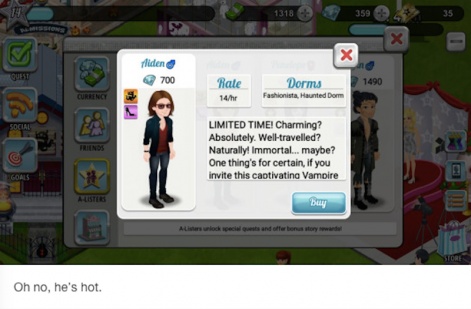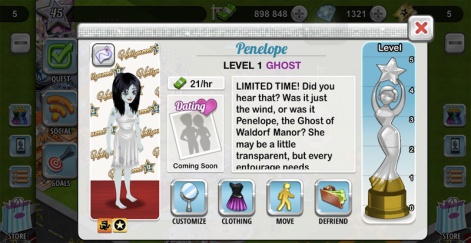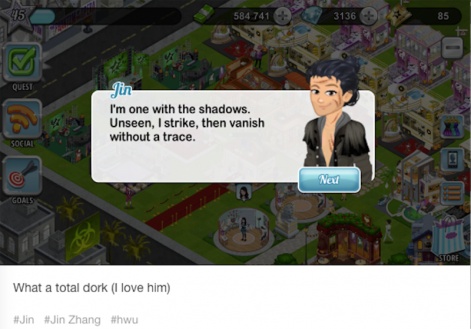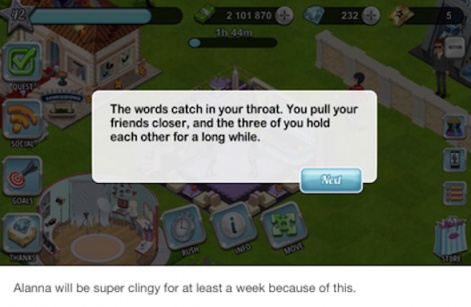PocketGamer.biz has partnered up with US developer Pixelberry Studios to highlight its candid stories on the trials and triumphs of a startup game studio whose debut title High School Story stayed in the top grossing top 100 chart for a year.
This bi-weekly series of articles will provide a mix of drama, detailed learnings, and actual numbers from their experience launching and supporting a top game.
In mid-October 2014, Hollywood U's sister game High School Story propelled itself from an overall App Store grossing rank of #273 all the way to #92 via a robust Halloween update.
We wanted to do the same thing this year for Hollywood U's first ever Halloween.
A sizable portion of the responsibility fell to the game's considerable story element, since, as we've learned from past experience, an engaging storyline creates a lot of the buzz and virality that ultimately leads to increased revenue.
The keys for us:
- Having a solid plan upfront.
- Creating compelling Halloween characters.
- Ensuring that all our stories included heartfelt, tender moments.
A solid plan
In August, when the dust of resource planning settled, we had enough bandwidth to add three unique, buyable Halloween characters to our store (in Hollywood U, these characters are called A-Listers).
Each A-Lister would come with an "upsell" quest, introducing the A-Lister and creating a strong incentive for players to buy them. We had to make each A-Lister so compelling that our players simply had to have them.
A robust Halloween update propelled High School Story from an overall App Store grossing rank of 273 to 92.
Each A-Lister would also come with a full-length bonus quest upon purchase that would continue their story. These quests act as extra incentive for players to spend premium currency.
Three A-Listers meant that we were committed to writing six quests. Two additional date quests brought the overall total to eight.
We also decided to launch two new types, zombies and vampires. Two types meant two more quests (now ten total).
Finally, we always try to include free content with our paid content - this generates a ton of goodwill from our players and can often lead those reluctant to spend real money into becoming spenders.
Therefore, we opted to release three free quests over the first three weeks of the update, making the final total 13 quests (a fitting number for Halloween).
Knowing our typical output for an update cycle (six to seven quests), we formed our plan. If we got a head start and pulled some of the writers from High School Story, we'd be able to write all thirteen quests in time.
Armed with a solid plan, we now knew how many quests we'd be writing and what types of quests they'd be.
But there was still one very important question: who were our A-Listers?
Compelling characters
It'd be hard to under-stress the importance of characterization for our games. Compelling personalities are an absolute essential.
A lot of decisions go into who they are, how they look, and what their stories are about.
Here are the three A-Listers we created for the update along with the decisions we made to make them as compelling as possible:
- Aiden the Vampire
For our primarily teenaged, female demographic, having a male vampire felt like a must-have for Halloween.

Twilight aside, vampires in general are all about the dichotomy of attraction and danger, both characteristics inherent to the Bad Boy archetype. Appearance-wise, we made our vampire a classically European one a la Dracula (for recognizability) and decided he'd be Irish in order to give him a slightly unusual backstory.
Thus, Aiden was born.
- The challenge of Aiden's story
For Aiden's upsell quest, we faced a tough problem - how could we bring this vampire character into the players' world without them feeling immediately threatened by him?
Our answer was twofold:
- if Aiden were being pursued by a clan of evil vampires, he'd seem vulnerable and therefore sympathetic, and
- if he concealed his vampire nature, then the player's character could be slightly more trusting of him. This would also promise an engaging scene later when his secret inevitably came out.
- Penelope the Ghost
With three characters, we needed at least one female character. We were excited to try a different-colored skin tone, so it made sense to include a ghost girl in the vein of The Ring.

Penelope ended up being ripe for tragedy... a ghost cooped up in an old house for years and then released, her story became a classic fish-out-of-water one.
- The challenge of Penelope's story
Penelope was tricky because normally we try to introduce A-listers in their quests immediately. That felt wrong for a ghost-related quest since typically ghosts aren't seen until the climax of their story.
Our solution was to make the story about ghost-hunting, with a build in tension that culminated with the player character discovering Penelope's existence relatively early, but then not meeting her until much later.
- Jin the Monster Hunter
From day one of planning, there was one character we knew we wanted: a monster hunter, a la Van Helsing. We knew that this character would possess a lot of the qualities desired by our players - he's ruggedly attractive (scars!), mysterious, an expert in his field, capable of protecting someone in danger, and a bit of an adorable dork.

Additionally, we're always conscious of diversity; since we knew that the ghost's skin was going to be a translucent color and that our vampire was going to be lighter-skinned, it made sense for the monster hunter to be non-white.
Looking at gaps in representation amongst our existing cast of characters, we decided he should be Chinese, and the result was Jin.
- The challenge of Jin's story
For Jin's upsell quest, we wanted him to hunt monsters, but we had the added problems of introducing hunt-able monsters that would be
- a) fun to fight,
- b) scary but not too scary,
- c) non-sympathetic, and
- d) familiar.
Among the many monsters we considered were werewolves, vampires, mummies, a creature from a black lagoon, even a plant monster. Finally, we found one that satisfied all those criteria - a spider army, all controlled by a giant queen spider.
Heartfelt, tender moments
Important as they are, characters can only do so much. In order to make our characters worthwhile, they need to feel real. That means making our players care about them a great deal.
Pixelberry has always been about positivity.
Pixelberry has always been about positivity. It's evident in our work to end cyber-bullying, in our campaign to bring about awareness of eating disorders, and most recently in our involvement with Global Goals.
It's also a significant aspect of our quests. Adding in moments of emotional depth create sympathy for our characters. Without it, they're just a bunch of talking heads. Here's one example from among our Halloween content:
In this scene, the player's character has been tricked into thinking their friends have all become victims of a zombie apocalypse. At the very end, the trick is revealed, and the player's character is reunited with their friends.

Thinking they'd forever lost those dear to them, the player's character sees their friends for what they really are - the most precious thing in their lives.
Results
With a solid plan, a trio of compelling characters, and many heartfelt, tender moments we created an engaging Halloween storyline.
Upon its release, the Halloween update catapulted Hollywood U from #370 to #159.
While story is only a small piece of the total work that went into the update, it's safe to say that our stories have played an important role in generating revenue and contributing to the update's current success.
Eric Dean is a Story Lead for Pixelberry Studios.
Through partnerships with non-profits, Pixelberry's hit game High School Story has taught millions of players about tough teen issues, like cyberbullying and eating disorders.
You can find out more at pixelberrystudios.com





















